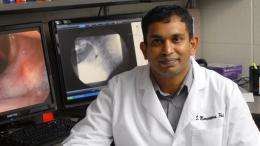Researcher 'Shows the Voice' in Swallowing Disorders

(PhysOrg.com) -- Using his background in aerospace engineering and signal processing, a UC researcher is finding new ways to help physicians listen to their patients: by teaching them to look at the signal, not the sound.
Shanmugam Murugappan, PhD, research assistant professor in the department of otolaryngology-head and neck surgery, is studying the acoustic signal of “wet voice” or “gurgly voice,” a type of voice produced when food material is on the larynx, which houses the vocal cords responsible for producing voice.
Patients with swallowing disorders are more likely to have “wet voice,” says Murugappan, because they’ve often lost sensation in their larynx. Once that happens, it’s easy for food or liquid to bypass the esophagus and land on the larynx. From there, it can slip down into the lungs and lead to respiratory complications.
He says physicians currently diagnose wet voice by listening to changes in the patient’s voice. But such a subjective method can lead to inconsistencies in diagnosis or treatment.
Instead, Murugappan is analyzing the sound produced by wet voice, finding different ways to represent the signal by displaying different acoustic behaviors.
“You need a training tool to say ‘this is the standard voice’ and ‘this is wet or gurgly voice’,” he says. “That definition is not there. So the goal of this work is to try and identify what defines a wet voice.”
Working with Suzanne Boyce, PhD, and Lisa Kelchner, PhD, of the UC College of Allied Health Sciences’ Department of Communications Sciences and Disorders, otolaryngology’s Sid Khosla, MD, and engineering's Ephraim Gutmark, PhD, Murugappan placed various consistencies of fluid onto a larynx model. Researchers then imitated voice production by blowing air over the model. The resulting sound is similar to the voice produced when material pools on a patient’s larynx.
His results showed clear differences in the sound’s behavior depending on what material was used.
Murugappan is presenting his work today at the 158th meeting of the Acoustical Society of Americain San Antonio.
By measuring the sensitivity or chaos of the sound, he says researchers can tell what, if any, material was present. They can even study different elements of the sound depending on how Murugappan analyzes the signal.
“People are used to looking at a signal one way, but you can actually take that signal and present it in a different form, which looks like an object in space,” he says. “You can take the same signal and you are now showing it in a different way … and it’s easier to study.”
He hopes these new characterizations will make it easier for physicians to identify swallowing disorders in patients.
“You can actually characterize the whole range of fluid and food material that you want to study. It can be developed into a database or a preliminary diagnostic tool to find out who would be the right candidate for further evaluation,” he says. “It also can help train the speech pathologists who are doing these exams in the first place.”
Provided by University of Cincinnati












